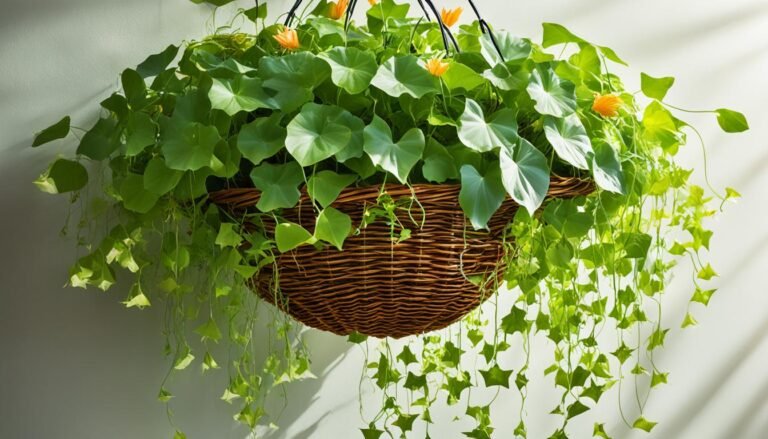Imagine stepping into a cozy garden filled with vibrant colors and delicate blooms. As you wander through the winding paths, you come across a breathtaking sight – a collection of lotus vine hanging baskets, gracefully cascading from a pergola. The rich sunset hues of the lotus vine flowers catch your eye, and you can’t help but be captivated by their beauty.
The lotus vine, also known as parrot’s beak, is a stunning flower that is perfect for hanging baskets. Its unique bloom form and striking colors make it a showstopper in any space. Whether you’re a seasoned gardener or a beginner, the lotus vine is a delightful addition to your outdoor oasis.
In this article, I will share expert care tips and creative ideas for your lotus vine hanging basket. From understanding what a lotus vine is to learning how to grow and care for it, you’ll discover everything you need to know to keep your lotus vine thriving.
Key Takeaways:
- Lotus vine hanging baskets bring vibrant colors and elegance to any space.
- The lotus vine, also known as parrot’s beak, is a tropical plant native to the Canary and Cape Verde Islands.
- Growing a lotus vine can be done from young plants or stem cuttings.
- Lotus vine care is relatively low-maintenance, requiring well-draining soil and regular watering.
- Creative ideas for lotus vine hanging baskets include pairing them with other trailing plants and using decorative baskets for added style.
What is a Lotus Vine?
The lotus vine, also known as parrot’s beak, is a tropical plant native to the Canary and Cape Verde Islands. It is commonly used as a trailing or border plant and is particularly popular for summer container gardens. The plant features gorgeous orange and red flowers with tapered petals and grayish-green foliage. It can be grown as a summer annual in warmer regions and is best suited for USDA plant hardiness zones 10 to 12.
Growing a Lotus Vine
When it comes to growing a lotus vine, you have two options: purchasing young plants from garden centers or starting them from stem cuttings. If you’re starting from seeds, it’s best to start them indoors about eight to ten weeks before transplanting. This will give them ample time to establish and develop strong roots.
Lotus vines thrive in well-draining soil, so make sure to choose a potting mix specifically designed for container gardening. Ensure that your hanging basket has adequate drainage holes to prevent waterlogging.
It’s important to water lotus vines deeply, allowing the top surface of the soil to dry out between waterings. This will help prevent root rot and ensure healthy growth. Remember to adjust the frequency of watering based on the temperature and humidity levels in your indoor environment.
For optimal growth and blooming, place your lotus vine in a location that receives full sun. Keep in mind that lotus vines are not frost-tolerant, so if temperatures are expected to drop below 45 degrees Fahrenheit, make sure to protect your plant by bringing it indoors or providing suitable shelter.
Lotus Vine Care Tips
Proper care is essential for the health and beauty of your lotus vine hanging basket. Fortunately, lotus vine care is relatively low-maintenance. With a few simple tips, you can ensure that your decorative hanging basket thrives and becomes the centerpiece of your space.
1. Pests and Diseases
The lotus vine is fairly resistant to pests and diseases. However, common issues that may arise include spider mites, mealybugs, and aphids. To control these pests, use horticultural oil according to the package instructions.
2. Soil Drainage
It is crucial to ensure that the soil in your hanging planter is well-draining. Avoid overly dry or waterlogged conditions, as these can harm the lotus vine’s roots. Check the moisture level regularly and water deeply when the top inch of soil feels dry.
3. Watering
Lotus vines require regular watering to stay healthy. However, it’s important not to let them sit in standing water, as this can lead to root rot. Allow the excess water to drain freely from the bottom of the hanging basket.
4. Fertilization
Regular fertilization is beneficial for lotus vines. Use a balanced liquid fertilizer or slow-release granules specifically formulated for flowering plants. Follow the package instructions for application rates and frequency.
5. Temperature
Lotus vines prefer moderate temperatures and tend to bloom best in cool weather. Place your hanging basket in a location where it receives optimal sunlight and moderate temperatures. Avoid exposing the plant to extreme heat or cold.

By following these care tips, you can enjoy the vibrant blooms and cascading foliage of the lotus vine in your hanging planter. With proper attention, your lotus vine will thrive and become a beautiful focal point in your home or garden.
Creative Ideas for Lotus Vine Hanging Baskets
Lotus vine hanging baskets offer a unique and eye-catching display. Here are some creative ideas to elevate your space:
- Mix lotus vines with other trailing plants, such as ivy or ferns, for a lush and textured look.
- Combine lotus vines with flowering annuals, such as petunias or zinnias, for a burst of color.
- Create a cascading effect by placing the hanging baskets at different heights. Use hooks or brackets to hang them from walls, pergolas, or fences.
- Consider using decorative hanging baskets, such as woven or ceramic ones, to add an extra touch of style to your display.
These ideas will help you create a stunning lotus vine hanging basket that will be the focal point of any space.
Lotus Vine as an Indoor Hanging Plant
Indoor hanging plants are a wonderful way to bring the beauty of nature into your home, and the lotus vine plant is no exception. With its stunning flowers and trailing foliage, the lotus vine can add a touch of elegance to any indoor space. Here are some care tips to help you successfully grow and maintain a lotus vine in an indoor hanging basket.
First and foremost, it’s important to choose the right location for your lotus vine. Place it near a window where it can receive ample sunlight. Lotuas vines thrive in bright and indirect light, so avoid placing them in direct sunlight, which can scorch the delicate leaves.
Indoor environments can sometimes be too hot or dry for lotus vines, which prefer moderate temperatures and some humidity. Keep your lotus vine away from heating vents or drafts, as these can cause stress and damage to the plant. You can increase humidity by placing a tray filled with water near the plant or using a humidifier.
Regularly check the moisture level of the soil in your lotus vine hanging basket. Water the plant when the top inch of soil feels dry to the touch. Be careful not to overwater, as excessive moisture can lead to root rot. Remember to provide adequate drainage by ensuring that your hanging basket has drainage holes.
Here’s a summary of care tips for your lotus vine indoor hanging plant:
| Care Tips for Lotus Vine Indoor Hanging Plants |
|---|
| Place in a bright location near a window, away from direct sunlight. |
| Avoid hot and dry environments; maintain moderate temperatures and some humidity. |
| Check soil moisture regularly; water when the top inch of soil feels dry. |
| Ensure proper drainage by using a hanging basket with drainage holes. |
With proper care and attention, your lotus vine will thrive as an indoor hanging plant, bringing a touch of beauty and elegance to your home.
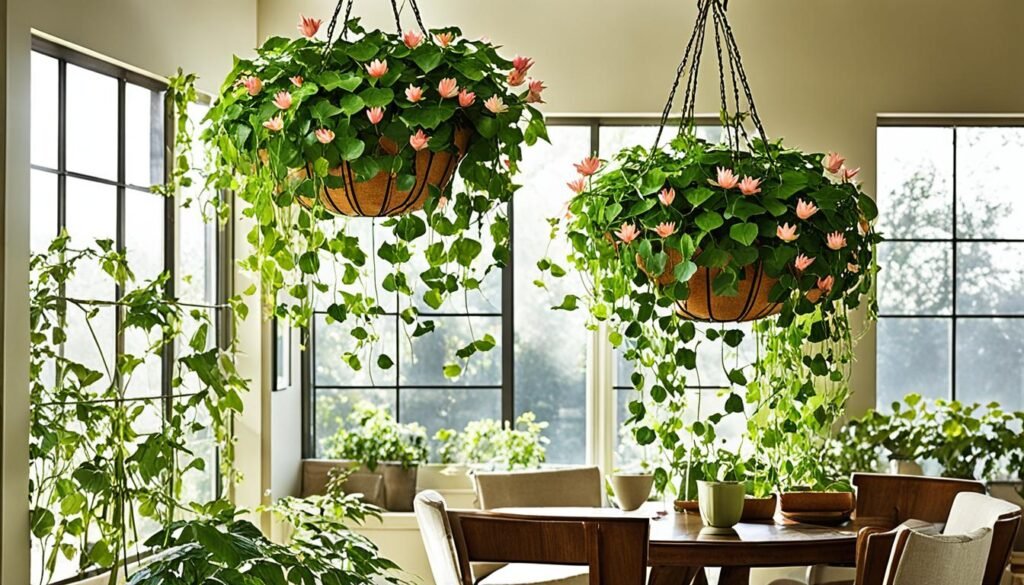
Best Hanging Plants for Different Spaces
Lotus vines are a great choice for hanging baskets, but there are many other plants that can thrive in different spaces. Here are some recommendations:
- Spider plants (Chlorophytum comosum): These plants have long, arching leaves and produce small white flowers. They are known for their air-purifying qualities.
- String of pearls (Senecio rowleyanus): This succulent plant features long trailing stems adorned with small round beads that resemble pearls.
- English ivy (Hedera helix): A classic hanging plant, English ivy has cascading vines with glossy green leaves.
- Ferns: Ferns are excellent for adding a lush and tropical feel to hanging baskets, with their delicate fronds.
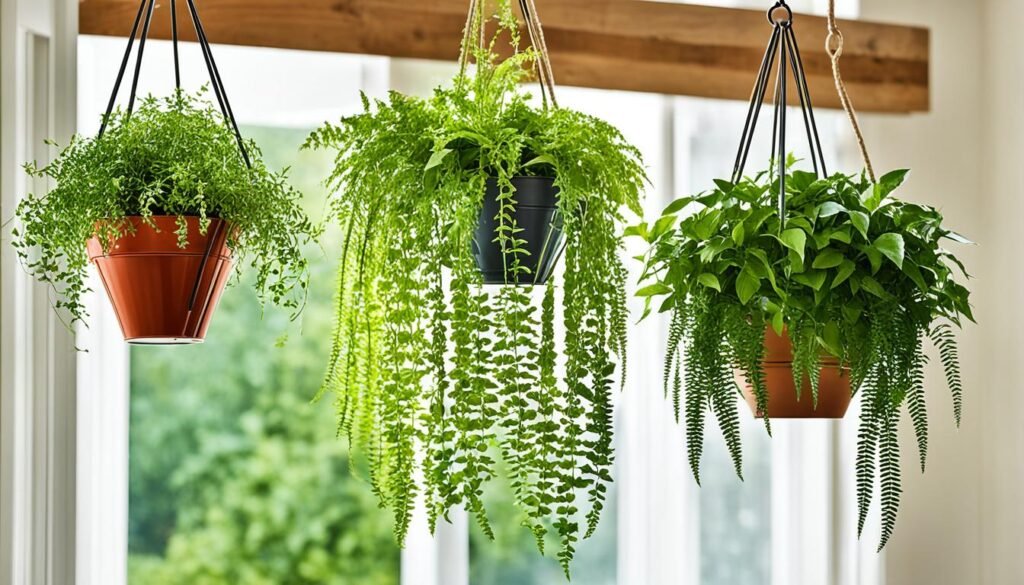
The vibrant lotus vine is not the only option when it comes to hanging plants. Spider plants, string of pearls, English ivy, and ferns offer different textures and aesthetics to suit your space.
Tips for Hanging Plant Care
Proper care is essential for the health and beauty of hanging plants. Here are some tips to keep in mind:
Choose the Right Location
Different plants have different light requirements, so it’s important to position your hanging baskets in the appropriate spot. Some plants prefer direct sunlight, while others thrive in partial shade. Take the time to research each plant’s specific needs and find the ideal location for your hanging baskets.
Water Appropriately
Most hanging plants require thorough watering, but it’s crucial not to overwater and cause root rot. Allow the soil to dry slightly between waterings to prevent waterlogged conditions. Check the moisture level by inserting your finger into the soil about an inch deep. If it feels dry, it’s time to water. Adjust your watering schedule based on the needs of each plant.
Fertilize Regularly
Hanging plants benefit from regular fertilization to ensure they receive essential nutrients for healthy growth. Use a balanced liquid fertilizer or slow-release granules according to the instructions on the package. Fertilize your plants every four to six weeks during the growing season to promote vibrant foliage and abundant blooms.
Prune and Maintain
To keep your hanging plants looking tidy and encourage new growth, it’s important to trim any dead or yellowing leaves regularly. Use clean, sharp scissors or pruning shears to remove damaged foliage. This will not only improve the overall appearance of your hanging baskets but also help prevent the spread of diseases or pests.

Lotus Vine in Rock Gardens
In addition to hanging baskets, lotus vines can also be planted in rock gardens for a stunning and unique display. The trailing nature and vibrant flowers of the lotus vine create a striking contrast against the rugged texture of rocks. Plant them in well-draining soil and choose a sunny location. Consider mixing them with other drought-tolerant plants and succulents for a low-maintenance rock garden design.
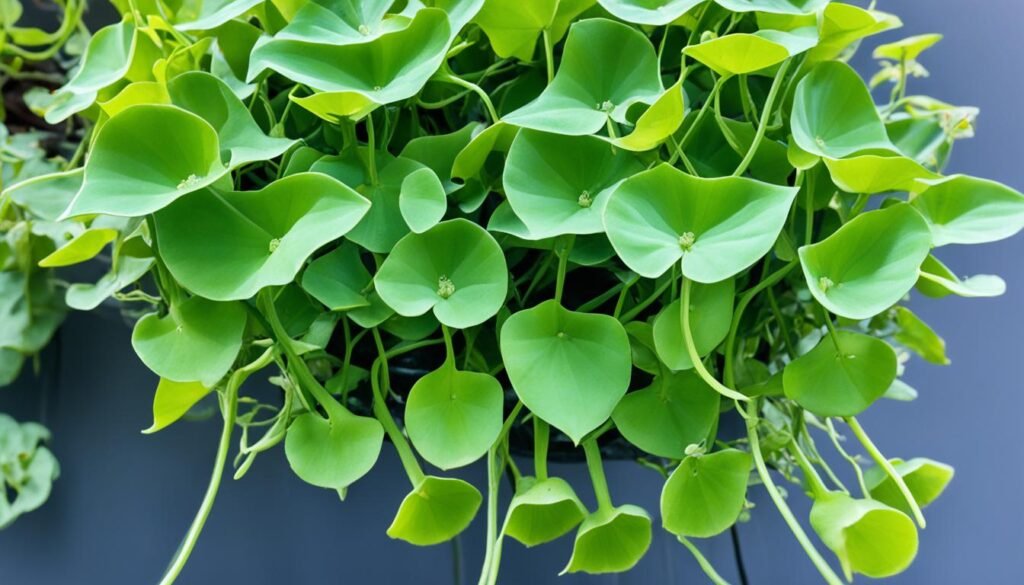
| Reasons to Include Lotus Vine in Rock Gardens: | Care Tips for Lotus Vine in Rock Gardens: |
|---|---|
|
|
Lotus Vine as a Groundcover
Lotus vines can also be used as a groundcover to fill in bare areas and add a splash of color. They are particularly well-suited for small areas and rock gardens. Plant them in well-draining soil and provide regular watering, especially during dry periods. Lotus vines can help suppress weed growth and provide a beautiful carpet of flowers and foliage.
| Benefits of Lotus Vine as a Groundcover | Requirements for Growing Lotus Vine as a Groundcover |
|---|---|
|
|
If you’re looking to create a visually stunning and low-maintenance groundcover, the lotus vine is an excellent choice. Plant it in well-draining soil and ensure it receives regular watering, particularly during dry periods. With its vibrant flowers and foliage, the lotus vine will transform bare areas into a colorful and captivating landscape. Take advantage of its weed-suppressing qualities, and enjoy the beauty it brings to your garden or rockery.

Best Companion Plants for Lotus Vine
Enhance the beauty of your lotus vine hanging baskets or garden plantings by pairing them with companion plants. Some great options include:
- Petunias (Petunia spp.): These colorful annuals are available in a wide range of hues and complement the vibrant flowers of lotus vines.
- Lobelia (Lobelia erinus): Lobelias are small, cascading flowers that come in various shades of blue, purple, and white, offering a delicate and charming contrast.
- Creeping Jenny (Lysimachia nummularia): This ground-hugging perennial has trailing stems with small yellow flowers and bright green leaves, providing a lovely contrast to the lotus vine’s foliage.
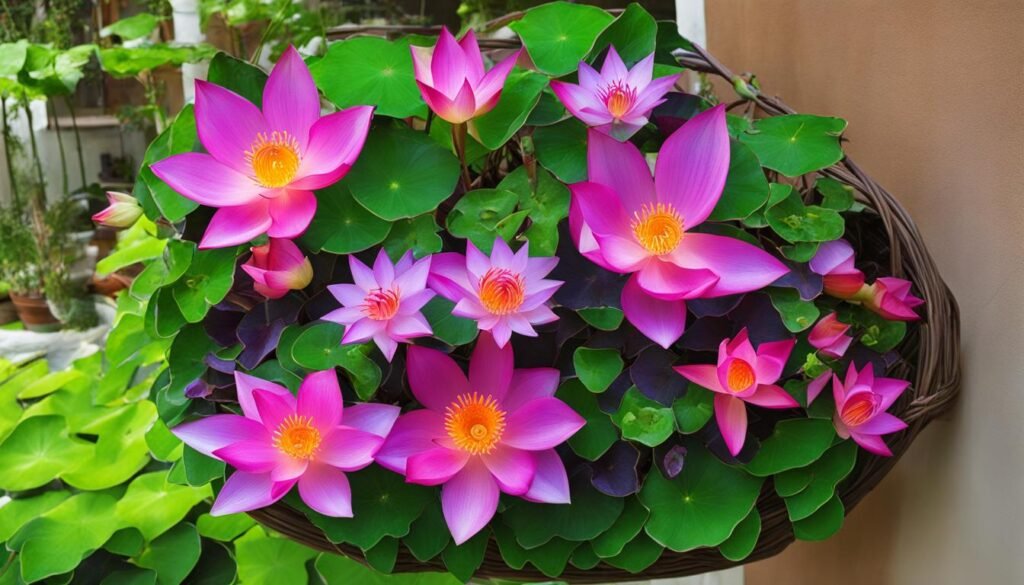
For a visually appealing combination, consider planting lotus vine hanging baskets alongside these companion plants. Their contrasting colors and growth habits will create a stunning display in your garden or on your patio.
Conclusion
Lotus vine hanging baskets are a stunning addition to any space, offering a unique and elegant touch with their vibrant blooms and cascading foliage. With proper care, these beautiful plants can thrive and bring joy throughout the season. Whether you’re looking to decorate your home or enhance your garden, lotus vine hanging baskets are a fantastic choice.
Get creative with your lotus vine hanging baskets by experimenting with different decorative ideas. Mix them with other trailing plants like ivy or ferns for a lush and textured look. For an extra burst of color, combine lotus vines with flowering annuals such as petunias or zinnias. Create a captivating display by hanging the baskets at different heights and using decorative hanging planters to add style to your space.
Remember to provide your lotus vine hanging baskets with the proper care they need. Ensure the soil is well-draining and water deeply, allowing the top surface to dry out between waterings. Protect them from temperatures below 45 degrees F and provide regular fertilization. With these care tips in mind, you can enjoy the beauty of lotus vine hanging baskets and create a personalized display that will elevate your home or garden.
